Walhalla (memorial)
The Walhalla is a hall of fame that honours laudable and distinguished people in German history – "politicians, sovereigns, scientists and artists of the German tongue";[1] thus the celebrities honoured are drawn from Greater Germany, a wider area than today's Germany, and even as far away as Britain in the case of several Anglo-Saxons who are honoured. The hall is a neo-classical building above the Danube River, in Donaustauf, east of Regensburg in Bavaria.
The Walhalla is named for the Valhalla of Norse Paganism. It was conceived in 1807 by Crown Prince Ludwig in order to support the gathering momentum for the unification of the many German states. Following his accession to the throne of Bavaria, construction took place between 1830 and 1842 under the supervision of the architect Leo von Klenze. The memorial displays some 65 plaques and 130 busts covering 2,000 years of history, beginning with Arminius, victor at the Battle of the Teutoburg Forest in AD 9.
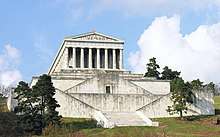
History
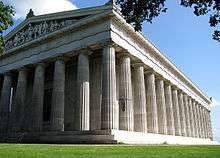
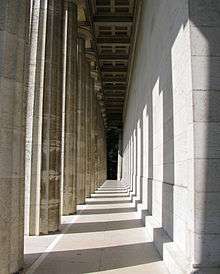
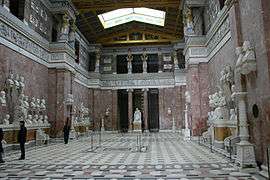
By 1806 Napoleon's First French Empire had annexed German lands along the Rhine River and the North Sea. Central German states formed the Confederation of the Rhine, which sided with Napoleon. Francis II, Holy Roman Emperor, then formally dissolved the Holy Roman Empire of the German Nation (6 August 1806) and instead styled himself Emperor of Austria. The War of the Fourth Coalition (1806-1807) pitted German forces on both sides against each other, and Napoleon again prevailed.
In 1807, 20-year-old Crown Prince Ludwig of the Kingdom of Bavaria (newly elevated from Electorate to Kingdom by Napoleon in 1806), had the idea of reminding all Germans of their common heritage – of the great figures and events in ethnic German history. He commissioned several sculptors to create busts of famous individuals of his choice. Johann Gottfried Schadow's bust of Nicolaus Copernicus became one of the first completed, in 1807. Further suggestions for individuals to be honoured were solicited in 1808 from Swiss historian Johannes von Müller.
By the time of Crown Prince Ludwig's coronation as King Ludwig I of Bavaria in 1825, 60 busts had been completed. In 1826 Ludwig commissioned the construction of a memorial above the Danube River, near Regensburg, modelled after the Parthenon in Athens. The southern pediment frieze features the 1815 creation of the German Confederation; the northern pediment frieze features scenes from the Battle of the Teutoburg Forest of 9 AD.[2] According to Pictorial Travels Continentally Described (circa 1892), the construction of the building cost £666,666.
A two thaler coin was minted commemorating the opening of the Walhalla, Krause catalog number KM# 811. It is moderately scarce.[3]
At Walhalla's inauguration on October 18, 1842, there were 96 busts, plus 64 plaques for persons or events of which no portrait was available on which to model a sculpture.
When the memorial was opened in 1842, Joseph Hartmann Stuntz authored a poem about Germany's greatness which was set to music by Joseph Hartmann Stuntz (two distinct men).[4]
Since being "of the German tongue" (viz., Germanic tongue) was the main selection criterion for the original 160 persons representing the 1,800 years of German history, the King included individuals of the wider Germanic sphere, including ancient Germanic notables as well as people from the Holy Roman Empire.
Whereas the Valhalla of Norse mythology served as home to those gloriously slain in battle, Ludwig intended his Walhalla not only for warriors but also for scientists, writers, and clerics, and specifically included both men and women. Decades before the foundation of the modern German state in 1871, "German" was understood as "Germanic", and included ancient Germanic (Gothic, Vandal, Lombardic, Anglo-Saxon) as well as medieval and modern Austrian, Dutch, Swedish and Swiss figures.
The first addition to the collection was the bust of Martin Luther. Ludwig, as a devout Catholic, had hesitated to include Luther. Several of the sculptors, including Ohnmacht and Schadow, had urged the king to include Luther, as did Johannes von Müller. Heinrich Heine (who would himself be inducted into the collection in 2010) mocked the omission in his satirical poem Praise to King Ludwig, saying: often, in naturalist collections of fish, the whale is missing.[5] Ludwig finally commissioned Luther's bust in 1831 from Ernst Friedrich Rietschel. It was not included at the inauguration of Walhalla in 1842, but added in 1848 by Ludwig himself. Luther's bust was placed just after the last of the original busts (Goethe's), disregarding the chronological arrangement by year of death.
Four further additions were made during Ludwig's lifetime: Archduke Charles, Duke of Teschen (died 1847, added 1853), Josef Wenzel Graf Radetzky von Radetz (died 1858, added in the same year), Friedrich Schelling (died 1854, added 1860) and Ludwig van Beethoven (added 1866).
In 1853, King Ludwig I established an additional Hall of Fame in Munich, specifically for Bavarians – the Ruhmeshalle. Nine of the Bavarian enshrinees have since become Walhalla enshrinees. Their busts in the Ruhmeshalle were destroyed in 1944, during a bombing raid, and have not been replaced. Instead, a plaque with their names tells of their transfer to Walhalla. King Ludwig I himself, who commissioned the Liberation Hall and other monuments, was also enshrined both at Walhalla and in the Ruhmeshalle.
Helmuth von Moltke the Elder was the last addition of a military leader (in 1910). After World War I, new additions focussed on artists and intellectuals. Beginning in 1933, when Kraft durch Freude and other National Socialist organizations promoted trips to Walhalla, visitor numbers increased exponentially. In 1937, when Hitler unveiled a Bruckner bust, 131,520 were counted.
The Walhalla memorial was reached by the Allied invasion of Germany in April 1945, by the US Third Army led by General George S. Patton.[6]
Additions since 1945 are proposed by private individuals or private foundations, who will also pay for the production of the new bust. Suggestions are reviewed by the Bavarian Academy of Sciences, based on which a recommendation is made by the Bavarian Ministry of the Interior. The final decision lies with the Bavarian Council of Ministers. Official practice since 1945 has been to favour "eminent figures from science or art, or individuals with extraordinary social or caritative merit".[7]
Nineteen busts have been added between 1945 and 2018, for an average interval of a little below four years between additions:
- Max Reger (1948)
- Adalbert Stifter (1954)
- Joseph von Eichendorff (1957)
- Wilhelm Conrad Röntgen (1959)
- Max von Pettenkofer (1962)
- Jakob Fugger (1967)
- Jean Paul (1973)
- Richard Strauss (1973)
- Carl Maria von Weber (1978)
- Gregor Mendel (1983)
- Albert Einstein (1990)
- Karolina Gerhardinger (1998)
- Konrad Adenauer (1999)
- Johannes Brahms (2000)
- Sophie Scholl (2003)
- Carl Friedrich Gauss (2007)
- Edith Stein (2009)
- Heinrich Heine (2010)
- Käthe Kollwitz (2018).
The addition of a bust of Max Planck is scheduled for 2019.[8]
List of people
Busts
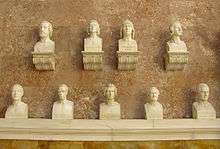

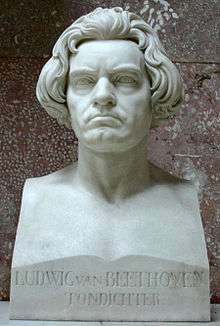
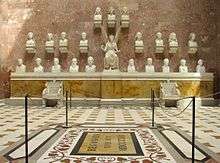
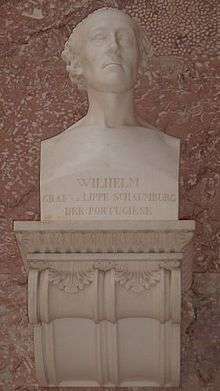
The original busts are arranged in rows by date of death At the inauguration in 1842, a total of 96 busts were arranged, in two rows, in chronological order (by year of death), beginning with Henry the Fowler (d. 936) and ending with Goethe (d. 1832). The upper row comprised 70 busts, beginning with Henry the Fowler and ending with Maria Theresa. The lower row comprised a total of 26 busts of modern scholars, beginning with Lessing and ending with Goethe.
Upper Row
- Busts to the left of the statue of Ludwig I
- 1. Henry the Fowler – Duke of Saxony and King of the Germans (1809)
- 2. Otto I, Holy Roman Emperor (Schadow, 1809)
- 3. Conrad II, Holy Roman Emperor (Schadow, 1809)
- 6. Frederick I, Holy Roman Emperor Marie Taeger (Schwanthaler, 1838)
- 7. Henry the Lion (d. 1195) – Duke of Saxony and Bavaria (Schadow, 1811)
- 8. Frederick II, Holy Roman Emperor (d. 1250) – Stupor mundi (Tieck, 1814)
- 9. Rudolf I of Habsburg (d. 1291) – German king (Tieck, 1832)
- 15. Erwin von Steinbach – architect of the Straßburger Münster (Ohmacht, 1811)
- 16. Johannes Gutenberg – inventor of movable type (Matthiä, 1835)
- 17. Jan van Eyck (d. 1441) – Flemish painter (Tieck, 1817–1842)
- 18. Frederick I, Elector Palatine – the Victorious, Elector of the Palatinate (Lossow, 1842)
- 24. Johannes Müller Regiomontanus (d. 1476) – astronomer and mathematician (Lossow, 1842)
- 25. Nicholas of Flue (d. 1487) – Swiss hermit, ascetic and mystic (Tieck, 1812)
- 26. Eberhard I. of Württemberg – Duke of Württemberg (Wagner, 1830)
- 27. Hans Memling (d. 1494) – Flemish painter (Woltreck, 1841)
- 28. Johann von Dalberg (1455–1503) – Bishop of Worms (second bust by Lossow, added after 1867[9])
- 29. Hans von Hallwyl (1433–1504) – Swiss commander at the Battle of Morat (Christen, 1812)
- 35. Berthold von Henneberg – Elector and Archbishop of Mainz (Mayer, 1824)
- 36. Maximilian I, Holy Roman Emperor (P. Kaufmann, 1811)
- 37. Johannes von Reuchlin – German philosopher and humanist (Imhof, 1835)
- 38. Franz von Sickingen – leader of the knighthood in Rhineland and Swabia (von Bandel, 1827)
- 39. Ulrich von Hutten – German knight and Renaissance humanist (Kirchmayer, 1811)
- 40. Albrecht Dürer (1471–1528) – printmaker and painter (Rauch, 1837)
- 41. Georg von Frundsberg – Knight and leader of Landsknechts (Widnmann, 1841)
- 47. Peter Vischer the Elder – German sculptor (F. Müller, 1839)
- 48. Johannes Aventinus (Johann Georg Turmair) – Bavarian scholar and historian (Horchler, 1841)
- 49. Wolter von Plettenberg – German Master of the Livonian Brothers of the Sword (L. Schwanthaler, 1832)
- 50. Erasmus of Rotterdam – Dutch humanist (Tieck, 1813)
- 51. Paracelsus (Theophrast von Hohenheim) – Swiss physician and alchemist (E. Wolff, 1827)
- 52. Nicolaus Copernicus – astronomer (Schadow, 1807)
- 58. Hans Holbein the Younger – German painter (Lossow, 1840)
- 59. Charles V, Holy Roman Emperor (Schwanthaler, 1842)
- 60. Christoph, Duke of Württemberg (Bissen, 1831)
- 61. Aegidius Tschudi – Swiss historian (Tieck, 1817)
- 67. William I of Orange – Dutch leader of the Eighty Years' War for the Dutch independence from Spain (Tieck, 1815)
- 68. Statue of Ludwig I of Bavaria (1890)
- Busts to the right of the statue of Ludwig I
- 69. August II the Strong – Elector of Saxony and King of Poland (Rietschel, 1840)
- 70. Julius Echter von Mespelbrunn – Bishop of Würzburg (Scholl, 1840)
- 71. Maurice of Orange – Dutch captain-general of the army of the Dutch Republic (Tieck, 1815)
- 72. Johannes Kepler – mathematician and astronomer (Schöpf, 1842)
- 73. Albrecht von Wallenstein – general in the Thirty Years' War (Tieck, 1812)
- 79. Bernhard of Saxe-Weimar – general in the Thirty Years' War (Tieck, 1812/13)
- 80. Peter Paul Rubens – Flemish painter (Lamine, 1809)
- 81. Anthony van Dyck – Flemish painter and engraver (Rauch, 1812)
- 82. Hugo Grotius – Dutch jurist (Tieck, 1814)
- 88. Maximilian von und zu Trauttmansdorff – Austrian diplomat that negotiated the Peace of Westphalia (Schaller, 1824)
- 89. Maximilian I (1573–1651) – Prince-elector of Bavaria (Imhof, 1832)
- 90. Amalie Elisabeth – Countess of Hesse-Kassel (Tieck, 1817)
- 91. Maarten Harpertszoon Tromp – Dutch admiral (Kessels, 1825)
- 92. Paris Graf von Lodron – Archbishop of Salzburg (Eberhard, 1814)
- 93. Frans Snyders – Flemish painter (Rauch, 1814)
- 99. Charles X Gustav – King of Sweden (Tieck, 1816)
- 100. Johann Philipp von Schönborn – Archbishop and Prince-elector of Mainz (Tieck, 1818)
- 101. Ernst I (1601–1675) – the Pious, Duke of Saxe-Gotha and Saxe-Altenburg (Tieck, 1815)
- 102. Michiel Adriaenszoon de Ruyter – Dutch admiral (Tieck, 1817)
- 103. Otto von Guericke – scientist and inventor (Rathgeber, 1811)
- 104. Frederick William, Elector of Brandenburg – the Great Elector (Wichmann, 1828)
- 105. Charles V, Duke of Lorraine (Tieck, 1817)
- 111. William III of Orange – Dutch Stadtholder and king of England, Scotland, and Ireland (Haller, 1816)
- 112. Ludwig Wilhelm von Baden – Türkenlouis, Imperial commander (Widnmann, 1842)
- 113. Gottfried Wilhelm Leibniz – philosopher and mathematician (Schadow, 1808)
- 114. Herman Boerhaave – Dutch humanist and physician (Leeb, 1823)
- 115. Maurice of Saxony – German commander and military strategist (Tieck, 1813)
- 116. Georg Friedrich Händel (1685–1759) – composer (Schadow, 1815)
- 122. Nikolaus Ludwig von Zinzendorf – religious and social reformer, bishop of the Moravian Church (Tieck, 1818)
- 123. Burkhard Christoph von Münnich – German field marshal in Russian service (Lossow, 1841)
- 124. Johann Joachim Winckelmann – archeologist and art writer (R. Schadow, 1814)
- 125. William, Count of Schaumburg-Lippe – Commander of his army in the Seven Years' War and for Portugal (Schadow, 1809)
- 127. Albrecht von Haller – Swiss anatomist and physiologist (Schadow, 1808)
- 128. Raphael Mengs – Bohemian painter (Rauch, 1808)
- 129. Maria Theresia (Eberhard, 1811/2)
Lower Row
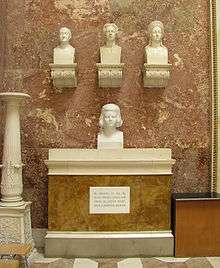
- Busts to the left of the statue of Ludwig I
- 4. Gotthold Ephraim Lessing (1729–1781) – poet (Tieck, 1813)
- 5. Frederick II of Prussia – Frederick the Great (Schadow, 1807)
- 10. Christoph Willibald Gluck – composer (Dannecker, 1812)
- 11. Ernst Gideon Freiherr von Laudon (1716–1790) – Austrian field marshal from Livonia (Kiesling, 1813)
- 12. Wolfgang Amadeus Mozart – composer (Schwanthaler, 1846)
- 13. Karl Wilhelm Ferdinand, Duke of Brunswick-Lüneburg – Prussian Generalfeldmarschall (Schadow, 1808)
- 14. Justus Möser (1720–1794) – jurist and historian (Schmidt von der Launitz, 1821)
- 19. Gottfried August Bürger – poet (Tieck, 1817)
- 20. Catherine II of Russia (1729–1796) – the Great, Tsarina of Russia (Wredow, 1831)
- 21. Friedrich Gottlieb Klopstock – poet (Schadow, 1808)
- 22. Johann Jakob Wilhelm Heinse – poet and scholar (Haller / Mayer, 1826)
- 23. Johann Gottfried Herder – poet and philosopher (Tieck, 1815)
- 30. Immanuel Kant – philosopher (Schadow, 1808)
- 31. Friedrich von Schiller – poet (Dannecker, 1794)
- 32. Joseph Haydn – composer (Robatz, 1810)
- 33. Johannes von Müller – Swiss historian (Schadow, 1808)
- 34. Christoph Martin Wieland – poet (Schadow, 1807)
- 42. Gerhard von Scharnhorst – Prussian general (Rauch, 1830)
- 43. Michael Andreas Barclay de Tolly – Russian Field Marshal (Widnmann, 1841)
- 44. Gebhard Leberecht von Blücher – Prussian Generalfeldmarschall (Rauch, 1817)
- 45. Karl Philipp Fürst zu Schwarzenberg – Austrian field marshal (Schaller, 1821)
- 46. Friedrich Wilhelm Herschel – astronomer (Eberhard, 1816)
- 53. Hans Karl von Diebitsch – Russian field marshal, born in Silesia
- 54. Karl vom und zum Stein – Prussian politician (1825)
- 55. August Graf Neidhardt von Gneisenau – Prussian field marshal (1842)
- 56. Johann Wolfgang von Goethe – poet and polymath (1808)
- 57. Martin Luther (1848) – Leader of the Reformation, translator of the Bible into German
- 62. Archduke Charles, Duke of Teschen (1853)
- 63. Josef Wenzel Graf Radetzky von Radetz – Bohemian military leader (1858)
- 64. Friedrich Schelling – German philosopher (1860)
- 65. Ludwig van Beethoven – composer (Lossow 1866)
- 66. Wilhelm I – German Emperor (1898)
- 68. Statue of Ludwig I of Bavaria (1890)
- Busts to the right of the statue of Ludwig I
- 74. Otto von Bismarck (1908) – Chancellor of North German Confederation and then of the German Empire
- 75. Helmuth Graf von Moltke (1910) – German Generalfeldmarschall
- 76. Richard Wagner (1913) – German composer of operas
- 77. Johann Sebastian Bach (1916) – composer
- 78. Justus von Liebig – German chemist (1925)
- 83. Friedrich Ludwig Jahn (1928)
- 84. Franz Peter Schubert (1925) – Austrian Romantic composer
- 85. Joseph Görres (1931)
- 86. Anton Bruckner (1937) – Austrian composer
- 87. Max Reger (1948) – German composer and organist of the late romantic period
- 94. Adalbert Stifter (1954)
- 95. Joseph Freiherr von Eichendorff (1957)
- 96. Wilhelm Conrad Röntgen (1959) – German physicist
- 97. Max von Pettenkofer – chemist and hygienist (1962)
- 98. Jakob Fugger (1967)
- 106. Jean Paul (1973)
- 107. Richard Strauss (1973) – German composer
- 108. Carl Maria von Weber (1978) – German composer
- 109. Gregor Joh. Mendel (1983) – Silesian Augustinian monk and naturalist[10]
- 110. Albert Einstein (1990) – physicist
- 117. Karolina Gerhardinger (1998) – founder of the School Sisters of Notre Dame
- 118. Konrad Adenauer (1999) – first Chancellor of West Germany
- 119. Johannes Brahms (2000) – Composer
- 120. Carl Friedrich Gauss (2007) – mathematician, astronomer, and physicist[11]
- 121. Edith Stein (2009) – philosopher and saint
- 126. Heinrich Heine (2010) – German Romantic poet
- 130. Sophie Scholl (2003) – German passive resistance activist against the Nazi regime.[12]
Plaques
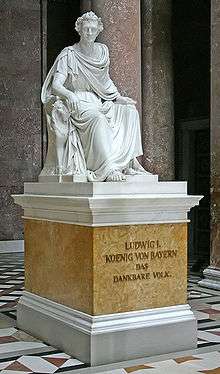
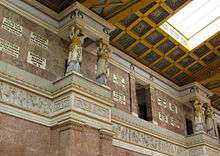
Plaques were made for people (or acts) of which no portraits or descriptions were available to model sculptures after. The timeline spans from Arminius a.k.a. Hermann der Cherusker (born 17 BC) to watchmaker Peter Henlein, who died in 1542. In 2003 a plaque was added to commemorate the German Resistance against Nazi Germany.
Plaque numbers 1–32 represent the upper row, 33–64 the lower row. Each plaque includes a short characterization of the individual, with the year of death given in Roman numerals. The year of death in the table below is that given on the plaque, even where modern historiography suggests a revised date.
| Nr | Name | Died | Description |
|---|---|---|---|
| 1 | Arminius | 21 | Leader of the Cherusci, victorious at the Battle of the Teutoburg Forest in AD 9. |
| 2 | Marbod | 40 | Leader of the Marcomanni |
| 3 | Veleda | after 65 | Prophetess |
| 4 | Julius Civilis | before 100 | Leader of the Batavi |
| 5 | Ermanarich | 375 | King of the Ostrogoths |
| 6 | Wulfila | before 380 | Apostle of the Goths |
| 7 | Fritigern | after 390 | Leader of the Tervingi |
| 8 | Alaric I | 410 | King of the Visigoths |
| 9 | Athaulf | 415 | King of the Visigoths |
| 10 | Theodoric I | 451 | King of the Visigoths |
| 11 | Horsa | 451 | Conqueror of Britain |
| 12 | Geiseric | 477 | King of the Vandals |
| 13 | Hengest | 480 | Conqueror of Britain |
| 14 | Odoacer | 497 | King of the Heruli and Gepidae |
| 15 | Clovis I | 511 | King of the Franks |
| 16 | Theodoric the Great | 526 | King of the Ostrogoths |
| 17 | Totila | 552 | King of the Ostrogoths |
| 18 | Alboin | 573 | King of the Lombards |
| 19 | Theudelinde | c. 626 | Queen of the Lombards |
| 20 | Emmeram von Regensburg | 680 | Bishop and Saint |
| 21 | Pippin of Herstal | 716 | Mayor of the Palace |
| 22 | Beda Venerabilis | 735 | Abbot and historiographer |
| 23 | Willibrord | 739 | Bishop and Saint |
| 24 | Charles Martel | 741 | Charles "the Hammer", Duke and Prince of the Franks and Mayor of the Palace |
| 25 | Bonifatius | 755 | Bishop and Saint |
| 26 | Pippin the Younger | 768 | Pippin "the Short", King of the Franks |
| 27 | Widukind | c. 800 | Leader of the Saxons |
| 28 | Paulus Diaconus | after 800 | Paul Warnefried, historiographer of the Lombards |
| 29 | Alcuin | 804 | Abbot and scholar |
| 30 | Ecgberht of Wessex | c. 810 | First King of England |
| 31 | Charlemagne | 814 | Charles the Great, Roman Emperor |
| 32 | Einhard | 839 | Historiographer, biographer of Charlemagne |
| 33 | Hrabanus Maurus | 856 | Bishop and scholar |
| 34 | Arnulf von Kärnten | 900 | Roman Emperor |
| 35 | Alfred the Great | 900 | King of England |
| 36 | Otto of Saxony | before 919 | Duke of Saxony |
| 37 | Arnulf of Bavaria | 937 | Duke of Bavaria |
| 38 | Matilda of Ringelheim | 968 | Queen of Germany and Saint |
| 39 | Hrotsvitha | before 1000 | Dramatist |
| 40 | Bernward of Hildesheim | 1028 | Artist, Bishop and Saint |
| 41 | Heribert von Köln | 1028 | Bishop and Saint |
| 42 | Henry III | 1056 | Holy Roman Emperor |
| 43 | Lampert von Hersfeld | 1077 | Historian |
| 44 | Otto von Bamberg | 1139 | Bishop |
| 45 | Otto von Freising | 1158 | Bishop and historian |
| 46 | Hildegard von Bingen | 1179 | Abbess and Saint |
| 47 | Otto of Bavaria | 1183 | Duke of Bavaria |
| 48 | Engelbert of Cologne | 1226 | Bishop and Saint |
| 49 | The anonymous poet of the Nibelungenlied | ||
| 50 | Walther von der Vogelweide | 1230 | Minnesinger |
| 51 | Elisabeth von Thüringen | 1231 | Princess and Saint |
| 52 | Leopold VI of Austria | 1234 | Leopold "the Glorious", Duke of Austria |
| 53 | Hermann von Salza | 1240 | Grand Master of the Teutonic Order |
| 54 | Wolfram von Eschenbach | 1251 | Minnesinger |
| 55 | Master Gerhard | 1271 | Architect of Cologne Cathedral |
| 56 | Arnold zum Turm | 1264 | Founder of the Rhenish League of Cities |
| 57 | Albertus Magnus | 1280 | Bishop and scholar |
| 58 | Rütlischwur | after 1306 | The three men of the Rütli oath, foundation of the Old Swiss Confederacy |
| 59 | Friedrich der Schöne | 1330 | Anti-king during the Interregnum |
| 60 | Bruno von Warendorp | 1369 | Leader of the Hanseatic League |
| 61 | Arnold Winkelried | 1386 | Knight, Swiss hero at Sempach |
| 62 | Wilhelm von Köln | 1388 | Painter |
| 63 | Adrian von Bubenberg | 1479 | Bernese military leader |
| 64 | Peter Henlein | 1542 | Inventor of the pocket watch |
The 65th plaque, dedicated to the Widerstand (Resistance) against Nazi Germany, added in 2003, is not part of the two rows of 64 numbered plaques.
See also
| Wikimedia Commons has media related to Walhalla. |
- Befreiungshalle (Hall of Liberation, Kelheim, Germany)
- Heldenberg Memorial (in Austria)
- Hermannsdenkmal (Hermann monument, Teutoburg Forest, Germany)
- Ruhmeshalle (Hall of Fame, Munich, Germany)
References
- Official Guide booklet, 2002, p. 3
- Official Guide booklet, 2002, p. 6
- German States BAVARIA 2 Thaler KM# 811 1842
- Institute of Bavarian History
- Steger (2011:190).
- Anna Rosmus Hitlers Nibelungen, Samples Grafenau 2015, p. 178
- Steger (2011:199)
- "Käthe Kollwitz und Max Planck kommen in die Walhalla", Welt, 19 December 2017.
- Steger (2011:191).
- Hynčice lie in Silesia.
- http://www.stmwfk.bayern.de/downloads/aviso/2004_1_aviso_48-49.pdf
- The bust of Sophie Scholl was inaugurated on February 22, 2003, the 60th anniversary of her execution. It is also intended as a representative of all the members of the Widerstand (the German Resistance against Nazi Germany), who have been honored with an additional plaque.
- Walhalla, official guide booklet, translated by Helen Stellner and David Hiley, Bernhard Bosse Verlag Regensburg, 2002
- Eveline G. Bouwers, Public Pantheons in Revolutionary Europe. Comparing Cultures of Remembrance, c. 1790-1840, Basingstoke 2012, pp. 161-212 (ISBN 978-0-230-29471-4)
- Adalbert Müller: Donaustauf and Walhalla (1846) at archive.org
- Simone Steger, Die Bildnisbüsten der Walhalla bei Donaustauf Von der Konzeption durch Ludwig I. von Bayern zur Ausführung (1807–1842), dissertation, Ludwig–Maximilian University, Munich (2011).
- Ludwig I of Bavaria, Walhalla's Genossen (1842, 2nd ed. 1847).
External links
| Look up Walhalla in Wiktionary, the free dictionary. |
- Walhalla official website (2009)